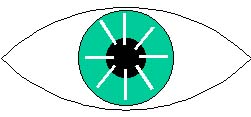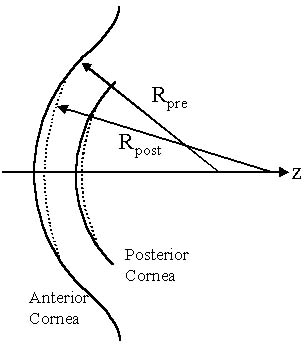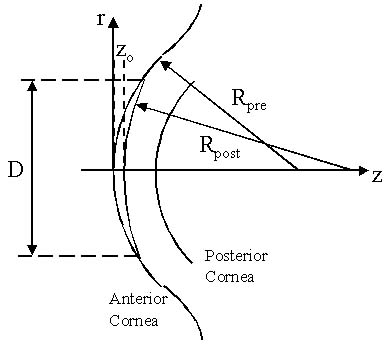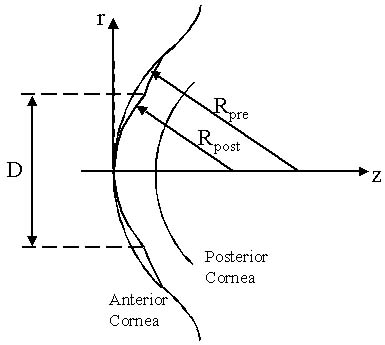Optics of Refractive Surgery
Introduction
In the past decade, refractive surgery has become a widespread means for reducing refractive error in the adult population. The two most prevalent techniques are incisional surgeries, such as radial keratotomy (RK) and astigmatic keratotomy (AK), and excimer laser surgeries, such as photorefractive keratectomy (PRK) and laser in situ keratomileusis (LASIK). All of these procedures are designed to modify corneal shape in order to change its refractive power. By altering this shape in a controlled manner, different types of refractive error can be treated. The incisional surgeries can reduce myopia and astigmatism, and the excimer laser surgeries can reduce myopia, hyperopia, and astigmatism. A description of the optics of the normal nonsurgical cornea and the effects of refractive procedures on this surface are described below.
Optics of the Normal Cornea
To better understand the optics of refractive surgery, it is useful to understand the optics of the normal cornea. The cornea is an aspheric surface, meaning that it is not perfectly round. The cornea is typically modeled as a prolate ellipsoid, which means that the cornea becomes flatter toward its periphery.1 This flattening affects the light rays that pass through the peripheral cornea differently than the light rays passing through the center of the cornea. Spherical aberration describes the difference in optical power between the periphery of an optic and its center. The normal cornea usually has positive spherical aberration, such that the rays entering the periphery of the cornea are myopic relative to the central rays. This positive spherical aberration is mostly compensated for by negative spherical aberration found in the crystalline lens. Therefore, the spherical aberration of the entire eye is mildly positive.2 Evolution has provided humans with an optical system that is well corrected. The effects of this residual spherical aberration are further reduced by the Stiles-Crawford effect.3 Overall, the optics of the eye are fairly good. Deviations from this natural level of aberration will, however, have significant visual consequences.
|
|
First-Order Changes Caused by Refractive Surgery
Spherical refractive error means the eye has the incorrect degree of power for its length. In the case of myopia, the power of the optics of the eye is too strong, thus causing light to focus in front of the retina. In hyperopia, the optical power is too weak, and, therefore, the light focuses to a point behind the retina. Because the anterior cornea is directly accessible to the surgeon, refractive surgeries have primarily focused on modifying corneal power to induce overall changes in the optical power of the eye and reduce refractive error.
In RK, a series of nonpenetrating radial incisions are made in the cornea in a spoke-like fashion. Slide 1A shows an example of an RK incision pattern. In this example, there are eight incisions placed horizontally and vertically and obliquely at 45º and 135º. The hub of the spoke pattern is called the optical zone and is the region in the center of the cornea that is untouched by the surgeon's scalpel. The RK incisions cut through the collagen bands that make up the bulk of the cornea and weaken the mechanical integrity of the structure. The reduced strength causes the cornea to sag, as shown in Slide 1B, thus flattening its curvature. Note that both the front and back surfaces of the cornea sag. The effect of RK is a reduction in the power of the cornea, which can be used as a treatment for myopic refractive error. The degree of correction obtained with this surgery depends on a number of factors, such as the depth and length of the incisions, size of the optical zone, total number of incisions, and patient factors such as age and healing response.4
Incisional surgery can also be used to treat astigmatism through AK. Corneal astigmatism is caused by the cornea having a toric shape. It therefore has a steep axis that has a high optical power and a flat axis 90º away that has a lower optical power. In AK, arcuate or linear incisions are made parallel to the limbus along the steep meridian of the cornea. The effect of these incisions is to flatten the steep axis of the cornea and steepen the flat axis of the cornea. Following AK treatment, the cornea will take on a more rotationally symmetric shape, so that the optical power is equal in all meridians. Optical coupling is the term used to describe one axis steeping while the other axis flattens. Optical coupling is a fortunate consequence of this procedure because it means that the average spherical power of the cornea is unaffected by AK and only the cylindrical error is modified. This feature allows the spherical equivalent refractive error to be treated by other techniques, such as RK, PRK, and LASIK, and then a correction of the astigmatism with the AK procedure. This advantage also appears in cataract surgery. Spherical power implants require a reduction in corneal astigmatism for patients with significant cylindrical error. AK allows for the correction of this corneal astigmatism, and because of optical coupling, no adjustments to the intraocular lens power are necessary. As with RK, the degree of correction obtained with this surgery depends on a number of factors, such as the length of the incisions, size of the optical zone, total number of incisions, and patient factors, such as age and healing response.
In PRK, an excimer laser is used to sculpt the cornea to a new shape. To correct for myopia, the anterior corneal radius of curvature is made flatter. Hyperopic errors are corrected by making the front corneal surface have a shorter radius of curvature, thus increasing its refractive power. Slide 2A and Slide2B show the changes in the anterior cornea needed for myopic and hyperopic corrections. Astigmatism can also be treated with PRK by altering the corneal shape as a function of meridian. To first order, LASIK has the same optical effects as PRK. In LASIK, a hinged flap of tissue is shaved in the anterior cornea. The excimer laser is used to sculpt the stroma, and the flap is then replaced. The pattern sculpted in the stroma is transferred through the flap and effectively modifies the shape of the anterior cornea. The tissue removed by PRK or LASIK surgery can be thought of as a "contact" lens with an index of refraction equal to that of the cornea. To determine the optical effects of PRK and LASIK, the optics of this "contact" lens need to be considered.
|
Munnerlyn and colleagues5 derived ablation
thickness profiles for myopic and hyperopic ablation patterns based on the
optics of a contact lens. This derivation assumed both thin lens theory and
paraxial optics. Removal of a lenticule of corneal tissue (height) is
equivalent to adding a thin negative lens of power
![]() given by:
given by:

where Rpre is the preoperative radius of curvature of the cornea, Rpost is the postoperative radius of curvature of the cornea, and n = 1.3771 is the index of refraction of the cornea. It should be noted here that the actual index of the cornea is required in equation (1) and not the keratometric index of refraction, nk = 1.3375, commonly used to represent corneal dioptric power. Slide 2A and Slide 2B show the preoperative corneal radius of curvature Rpre, the desired postoperative radius of curvature Rpost, the ablation optical zone diameter D, and the central ablation depth Zo for a myopic ablation. The tissue in the region between the preoperative cornea and the postoperative cornea can be considered a contact lens of diameter D.
In the Munnerlyn derivation, the preoperative cornea is assumed to be a sphere. The elevation of the preoperative corneal surface zpre is given by:
![]()
where r is the radial coordinate shown in Slide 2A and Slide 2B . Similarly, the elevation of the postoperative cornea is assumed spherical and is given by:
![]()
where again zo is the central thickness (height) of the ablation pattern. Equation (3) is only valid for the region inside the ablation optical zone (r < D/2). At the edge of the ablation optical zone, r = D/2, the elevation of the pre- and postoperative cornea must be equal. In other words, zpre(D/2) = zpost(D/2) at the edge of the treatment. Furthermore, equation (1) can be solved for Rpost, and the result can be substituted into equation (3). Using these two relationships, the ablation depth zabl(r) is then given by

Equation (4) is equivalent to equation (2) in Munnerlyn and colleagues,5 except for a change in notation and sign convention. A negative value of zabl represents the removal of corneal tissue in this case, whereas the preceding work had a positive value corresponding to tissue removal. Equation (4) can be extended to incorporate astigmatic correction by superimposing a cylindrical ablation pattern onto the rotationally symmetric pattern described above.
RK, PRK, and LASIK are all techniques for correcting refractive error. The basic premise behind these surgeries is to modify the radius of curvature of the anterior cornea and thus affect the overall power of the eye in a controlled fashion. This change in radius of curvature represents a first-order change in the surface in that it only affects the power of the cornea. Other secondary optical effects also occur with these procedures that affect vision. These additional effects are described below.
Second-Order Changes Caused by Refractive Surgery
Secondary optical effects such as diffraction, scatter, multifocality, and aberrations also arise in refractive surgery procedures. Diffraction is a deviation in the path light takes through the eye due to interactions with the physical structures within the eye. Diffraction always occurs due to the pupil, as light interacts with the boundary of the iris while passing through to the retina. This diffraction causes a deviation in the light rays that limits the size of the focal spot on the retina. Diffraction also occurs in the case of RK and AK if the incisions encroach on the entrance pupil of the eye. As light comes into the postincisional surgery eye, it interacts with the scar material formed at each incision location. Diffraction causes this light to be deviated into a diffraction pattern on the retina. The diffraction pattern of a straight line, such as an incision, is a line of light perpendicular to the incision formed on the retina. Thus, with the spoke-like pattern found in RK, the diffraction pattern will also have a spoke-like appearance on the retina. The resulting pattern is the starburst pattern that many RK patients complain about in their night vision. Night vision of these patients is most affected by diffraction because their iris diameter enlarges, causing more encroachment of the incisions on the entrance pupil.
Scatter is also a diffractive effect, but it is usually reserved for situations where a series of tiny opaque particles lie in the optical path. Fog is a good example of scattering. Innumerable water vapor particles deflect light randomly as the light tries to pass through the fog. The result is that only a portion of the light gets through the fog undeviated, and the remainder is sent off in all different directions. The optical effect of scatter is to reduce contrast. In the eye, scattered light veils the focused image falling on the retina. Scatter occasionally shows up in PRK and LASIK. The surface of the cornea in PRK and the flap interface in LASIK sometimes appears hazy. This haze is from light entering the eye being scattered back out of the eye. The degree of haze is proportional to the degree of visual effect it will have on the patient.
Multifocality occurs when different regions of the optics of the eye have different powers. Multifocality causes different images, some in focus and some out of focus, to be simultaneously presented to the retina. Multifocal optics are most familiar in the form of multifocal intraocular lenses and contacts. The lenses typically have annular regions of alternating near and distance power and are used as a treatment for presbyopia. However, similar multifocal effects can occur in PRK and LASIK patients with large pupils. In examining Slide 2A and Slide 2B , if the entrance pupil becomes larger than the optical zone of the ablation pattern, then the patient will have a multifocal effect. Ignoring the blending zone for the moment, PRK and LASIK patients will have one optical power corresponding to the patient's postoperative correction, in the central portion of their pupils, and a second optical power corresponding to the patient's preoperative refractive error in an annular region at the edge of the pupil. In reality, there is a blend zone that smoothes the transition from the optical zone to the untreated cornea. The blend zone gives a multitude of optical powers for patients with large pupils. Multifocality obviously becomes more of an issue in low light situations because the pupil dilates under these conditions.
Aberrations occur following refractive surgery due to irregularities in corneal shape. Spherical aberration occurs if the cornea has the improper aspheric shape following surgery. Recall from above that the normal cornea is prolate, meaning that the peripheral cornea flattens. This flattening introduces positive spherical aberration, which is largely compensated by the negative spherical aberration of the crystalline lens. Refractive surgeries such as RK, PRK, and LASIK tend to make the postoperative cornea oblate, meaning that the overall spherical aberration of the eye is dramatically elevated relative to normal values.6,7 The consequence of this elevation is haloes around bright lights. Another aberration that is common following refractive surgery is coma. Coma is caused by an asymmetry in the optics of the eye and is usually associated with an off-center treatment in both incisional and laser surgeries. The optical consequence of coma is that lights appear to flare out to one side. In fact, the name coma is derived from the comet-like appearance that these lights will have. Finally, higher-order aberrations appear due to these surgeries. Higher-order aberrations are an amalgam of any irregularities in the optics, such surface undulations. The optical effects of these aberrations depend upon the magnitude and distribution of the irregularities.
Discussion
Much of the ongoing research in refractive surgery is to reduce the second-order effects in excimer laser refractive surgery. Modifications to beam profiles, pulse energy, scanning techniques, and blending zones are designed to produce a smoother optical surface following PRK and LASIK. Smoother surfaces should dramatically reduce the effects of scatter. Larger ablation diameters and optical zones are being used to eliminate multifocal effects and to treat patients with large pupil sizes. Wavefront sensing is being used to assess the aberrations of the eye and eventually to correct for them. Finally, eye tracking is being employed to eliminate decentered ablation patterns. The goal of refractive surgery is to give the patient the best possible vision across a range of lighting conditions. In order to do so, the second-order optical effects described above need to be taken into account.
References
- Kiely PM, Smith G, Carney LG. The mean shape of the human cornea. Optica Acta. 1982;29:1027-1040.
- El Hage SG, Berny F. Contribution of the crystalline lens to the spherical aberration of the eye. J Opt Soc Am. 1973;63:205-211.
- Stiles WS, Crawford BH. The luminous efficiency of rays entering the eye pupil at different points. Proc R Soc London B Biol Sci. 1933;112:428-450.
- Holladay JT, Lynn MJ, Waring GO III, Gemmill M, Keehn GC, Fielding B. The relationship of visual acuity, refractive error, and pupil size after radial keratotomy. Arch Ophthalmol. 1991;109:70-76.
- Munnerlyn CR, Koons SJ, Marshall J. Photorefractive keratectomy: a technique for laser refractive surgery. J Cataract Refract Surg. 1988;14:46-52.
- Schwiegerling J, Greivenkamp JE, Miller JM, Snyder RW, Palmer ML. Optical modeling of radial keratotomy incision patterns. Am J Ophthalmol. 1996;122:808-817.
- Schwiegerling J, Snyder RW. Corneal ablation patterns to correct for spherical aberration in photorefractive keratectomy. J Cataract Refract Surg. 2000;26:214-221.




